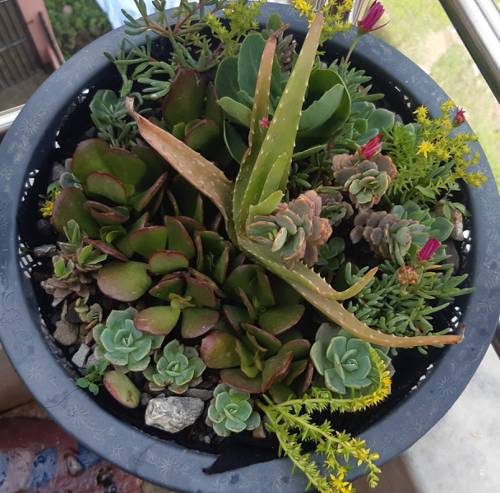
FAQ About Indoor Plant Habitats and Ecosystems

What are indoor plant habitats?
Indoor plant habitats refer to the environmental conditions and micro-ecosystems created by and for plants grown indoors. This includes the combination of light, humidity, temperature, soil, and companionship with other plants or supportive elements, all working together to mimic natural growing conditions.

How do indoor plants create symbiotic ecosystems?
Indoor plants create symbiotic ecosystems by interacting with each other and their environment in beneficial ways. For example, some plants can improve air quality by absorbing toxins, while others might release nutrients into the soil that nearby plants need. These interactions can promote healthier growth and more biodiversity within the indoor setting.

What are the benefits of having an indoor plant ecosystem?
Indoor plant ecosystems offer various benefits, including improved air quality, increased humidity, reduced stress, and enhanced aesthetic appeal. They also encourage biodiversity and offer learning opportunities about plant relationships and ecology.

Which plants are best for creating an indoor ecosystem?
Plants such as pothos, spider plants, ferns, and peace lilies are ideal for creating an indoor ecosystem. These plants are known for their air-purifying qualities and ability to thrive in various indoor conditions, often complementing each other in terms of growth requirements and benefits.

How do indoor plant ecosystems help with air purification?
Indoor plant ecosystems help with air purification by absorbing pollutants such as formaldehyde, benzene, and trichloroethylene through their leaves. As part of their photosynthesis process, plants convert carbon dioxide into oxygen, thus contributing to cleaner indoor air.

Can indoor plant ecosystems influence humidity levels?
Yes, indoor plant ecosystems can significantly influence humidity levels. Through a process called transpiration, plants release moisture from their leaves into the air, helping to increase the humidity in their immediate environment. This can be particularly beneficial in drier indoor spaces.

What is the role of soil in indoor plant ecosystems?
Soil is a crucial component of indoor plant ecosystems as it provides the necessary nutrients, water, and support for plant roots. Different types of soil can influence water retention, nutrient availability, and aeration, all of which are vital for healthy plant growth. Additionally, the soil can be home to beneficial microorganisms that enhance nutrient cycling and plant health.

How can companion planting benefit indoor plant ecosystems?
Companion planting involves growing different plants together to benefit each other. In indoor plant ecosystems, this can improve pest resistance, enhance growth by sharing nutrients, and provide structural support. For instance, combining taller plants that provide shade with lower light-loving plants can create a balanced environment.

Can indoor plant ecosystems support wildlife?
While indoor plant ecosystems are limited compared to outdoor ones, they can still support small forms of wildlife. This might include beneficial insects that pollinate or control pests, or microorganisms in the soil that help maintain plant health.

What challenges might arise in maintaining indoor plant ecosystems?
Challenges in maintaining indoor plant ecosystems include managing light levels, controlling humidity and temperature, preventing pests, and ensuring all plants have suitable soil and nutrients. Regular monitoring and adapting care routines are necessary to keep the ecosystem balanced and thriving.

How often should you water an indoor plant ecosystem?
The frequency of watering an indoor plant ecosystem depends on factors such as plant species, pot size, light exposure, and climate conditions within the home. Generally, it's best to check the soil moisture levels and water when the top inch feels dry, but specific needs may vary between ecosystems.

What are the signs of a healthy indoor plant ecosystem?
Signs of a healthy indoor plant ecosystem include vibrant plant coloration, steady growth rates, clean leaves, minimal leaf-drop, and an absence of pests. Additionally, the soil should be rich, well-aerated, and smell earthy without any foul odors indicative of poor conditions.

How does lighting affect indoor plant ecosystems?
Lighting plays a critical role in indoor plant ecosystems. Adequate lighting is necessary for photosynthesis, which is the process by which plants produce energy. Depending on the plant species, you may need direct sunlight, indirect light, or artificial grow lights to maintain their health and vitality.

Can you create an indoor plant ecosystem with artificial lighting?
Yes, artificial lighting can successfully create an indoor plant ecosystem. Specialized grow lights that mimic the full spectrum of sunlight are used to provide the necessary light for photosynthesis in spaces lacking natural light, ensuring that plants can thrive indoors.

What role do temperature and humidity play in indoor plant ecosystems?
Temperature and humidity are crucial for the growth and health of indoor plant ecosystems. Most indoor plants prefer temperatures between 60-75°F (15-24°C), and humidity levels around 40-60%. Deviations can stress plants, affecting their growth and overall health.

Can certain indoor plant combinations improve mental health?
Yes, certain indoor plant combinations can positively impact mental health by enhancing the aesthetic of living spaces, reducing stress, and improving air quality. For instance, mixing flowering plants with lush green foliage can be particularly soothing and create a serene environment.

What technology can assist in maintaining indoor plant ecosystems?
There are several technologies available to assist in maintaining indoor plant ecosystems, including smart plant sensors, automated watering systems, and app-enabled grow lights. These tools can help monitor environmental conditions and automate care tasks, making plant management easier.

How does plant diversity affect indoor ecosystems?
Plant diversity can enhance an indoor ecosystem by promoting resilience to pests and diseases, optimizing space utilization, and creating a more visually appealing environment. Diverse plant species may also fulfill different ecological roles, such as nitrogen-fixing or air purification, contributing to a more balanced habitat.

Are there specific containers that work better for indoor plant ecosystems?
Yes, certain containers are better suited for indoor plant ecosystems. Containers with good drainage and breathable materials like terracotta are preferred as they prevent waterlogging and allow for air circulation, which is essential for root health.

How can indoor plant ecosystems be adapted for small spaces?
Indoor plant ecosystems can be adapted for small spaces by using vertical gardening techniques, selecting compact plant varieties, and utilizing multi-tiered or hanging planters. These strategies maximize limited space while still allowing for a variety of plants to grow harmoniously.
